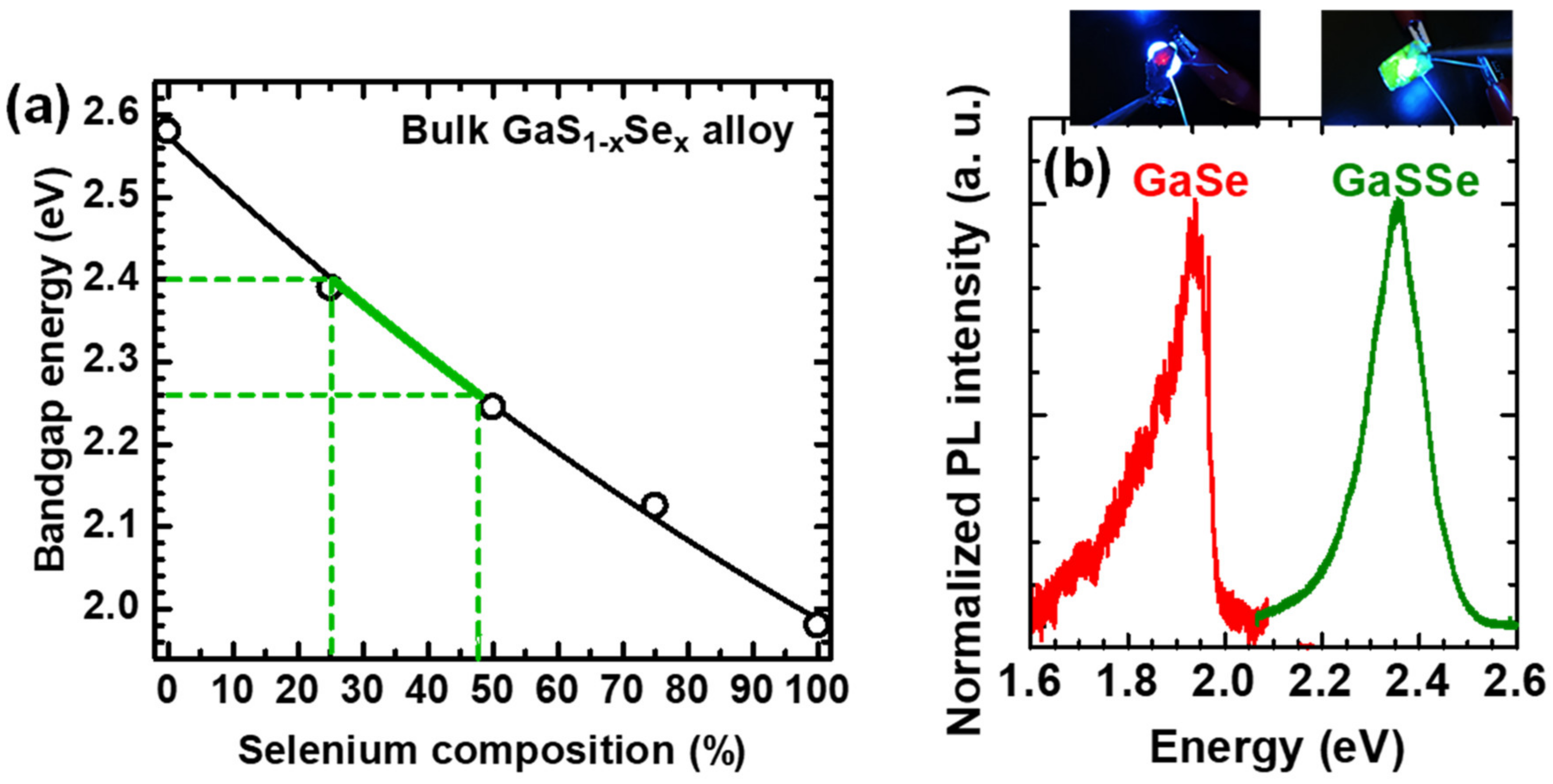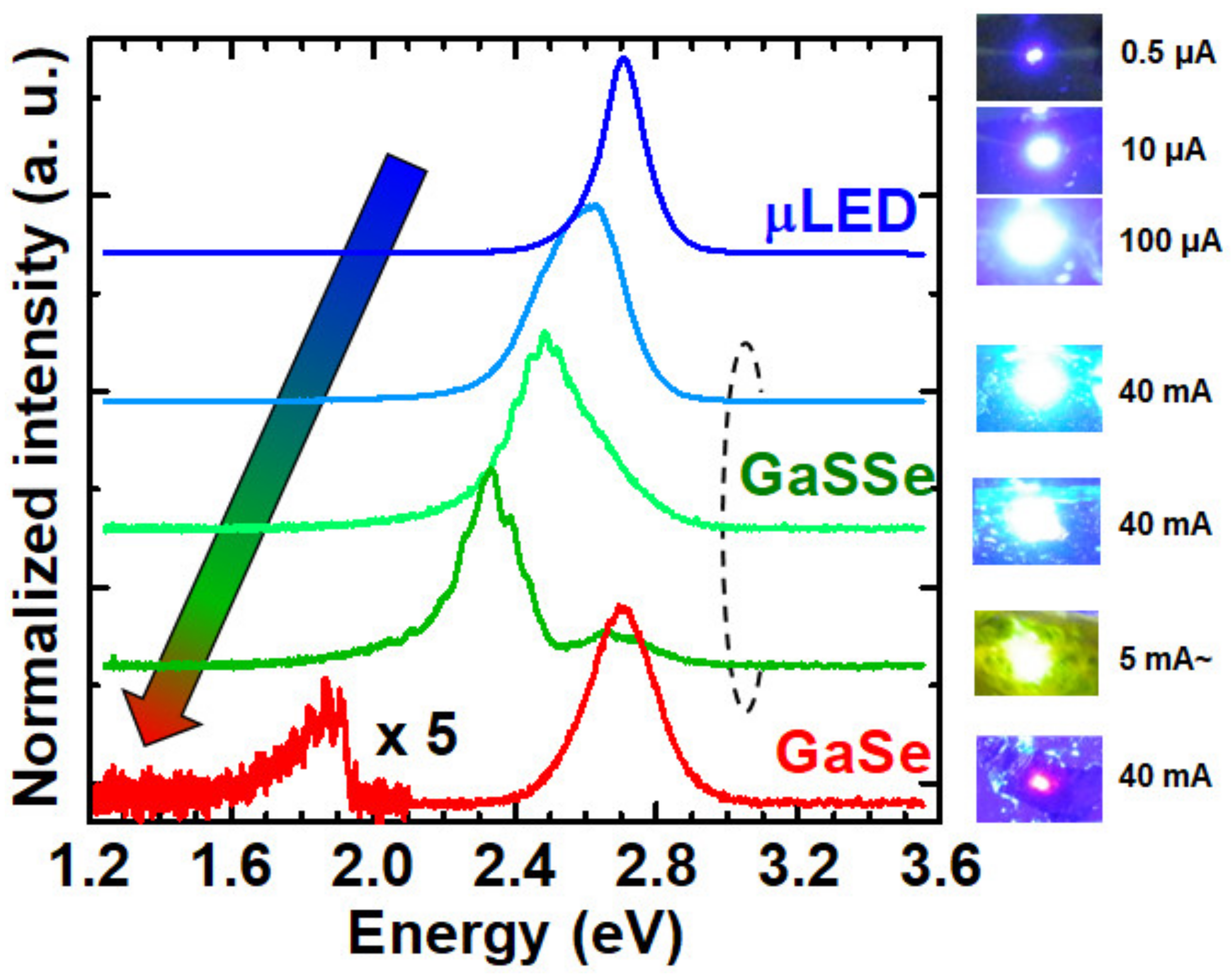Photoluminescence of Layered Semiconductor Materials for Emission-Color Conversion of Blue Micro Light-Emitting Diode (µLED)
Abstract
:1. Introduction
2. Materials and Method
3. Results and Discussion
3.1. Compositions of Layered GaS1−xSex Alloy for Green and Red Luminescenes
3.2. Demonstration of the Emission-Color Conversion of Blue μLED Utilizing GaS0.65Se0.35 and GaS Thin Films
4. Conclusions
Supplementary Materials
Author Contributions
Funding
Acknowledgments
Conflicts of Interest
References
- Wu, T.; Sher, C.-W.; Lin, Y.; Lee, C.-F.; Liang, S.; Lu, Y.; Chen, S.-W.H.; Guo, W.; Kuo, H.-C.; Chen, Z. Mini-LED and Micro-LED: Promising Candidates for the Next Generation Display Technology. Appl. Sci. 2018, 8, 1557. [Google Scholar] [CrossRef] [Green Version]
- Huang, Y.; Ten, G.; Gou, F.; Li, M.-C.; Lee, S.-L.; Wu, S.-T. Prospects and challenges of mini-LED and micro-LED displays. J. Soc. Inf. Display 2019, 27, 387–401. [Google Scholar] [CrossRef]
- Lee, H.E.; Shin, J.H.; Park, J.H.; Hong, S.K.; Park, S.H.; Lee, S.H.; Lee, H.H.; Kang, I.-S.; Lee, K.J. Micro Light-Emitting Diodes for Display and Flexible Biomedical Applications. Adv. Funct. Mater. 2019, 29, 1808075. [Google Scholar] [CrossRef]
- Chen, K.-J.; Chen, H.-C.; Tsai, K.-A.; Lin, C.-C.; Tsai, H.-H.; Chien, S.-H.; Cheng, B.-S.; Hsu, Y.-J.; Shih, M.-H.; Tsai, C.-H.; et al. Resonant-Enhanced Full-Color Emission of Quantum-Dot-Based Display Technology Using a Pulsed Spray Method. Adv. Funct. Mater. 2012, 22, 5138–5143. [Google Scholar] [CrossRef]
- Han, H.-V.; Lin, H.-Y.; Lin, C.-C.; Chong, W.-C.; Li, J.-R.; Chen, K.-J.; Yu, P.; Chen, T.-M.; Chen, H.-M.; Lau, K.-M.; et al. Resonant-enhanced full-color emission of quantum-dot-based micro LED display technology. Opt. Express 2015, 23, 32504–32515. [Google Scholar] [CrossRef]
- Chen, G.-S.; Wei, B.-Y.; Lee, C.-T.; Lee, H.-Y. Monolithic Red/Green/Blue Micro-LEDs With HBR and DBR Structure. IEEE Photon. Technol. Lett. 2018, 30, 262–265. [Google Scholar] [CrossRef]
- Tao, T.; Zhi, T.; Cen, Z.; Liu, B.; Wang, Q.; Xie, Z.; Chen, P.; Chen, D.; Zhou, Y.; Zheng, Y.; et al. Hybrid Cyan Nitride/Red Phosphors White Light-Emitting Diodes With Micro-Hole Structure. IEEE Photon. J. 2018, 10, 8201608. [Google Scholar] [CrossRef]
- Gou, F.; Hsiang, E.-L.; Tan, G.; Lan, Y.-F.; Tsai, C.-Y.; Wu, S.-T. High performance color-converted micro-LED displays. J. Soc. Inf. Display 2019, 27, 199–206. [Google Scholar] [CrossRef]
- Wang, Z.; Shan, X.; Cui, X.; Tian, P. Characteristics and techniques of GaN-based micro-LEDs for application in next-generation display. J. Semicond. 2020, 41, 041606. [Google Scholar] [CrossRef]
- Haase, M.A.; Xie, J.; Ballen, T.A.; Zhang, J.; Hao, B.; Yang, Z.H.; Miler, T.J.; Sun, X.; Smith, T.L.; Leatherdale, C.A. II-V-semiconductor color converters for efficient green, yellow, and red light emitting diodes. Appl. Phys. Lett. 2010, 96, 231116. [Google Scholar] [CrossRef]
- Santos, J.M.M.; Jones, B.E.; Schlosser, P.J.; Watson, S.; Herrnsdorf, J.; Guihabert, B.; McKendry, J.J.D.; Jessus, J.D.; Garcia, T.A.; Tamargo, M.C.; et al. Hybrid GaN LED with capillary-bonded II-VI MQW color-converting membrane for visible light communications. Semicond. Sci. Technol. 2015, 30, 035012. [Google Scholar] [CrossRef] [Green Version]
- Butler, S.Z.; Hollen, S.M.; Cao, L.; Cui, Y.; Gupta, J.A.; Gutiérrez, H.R.; Heinz, T.F.; Hong, S.S.; Huang, J.; Ismach, A.F.; et al. Progress, Challenges, and Opportunities in Two-Dimensional Materials Beyond Graphene. ACS Nano 2013, 7, 2898–2926. [Google Scholar] [CrossRef] [PubMed]
- Ponraj, J.S.; Xu, Z.-Q.; Dhanabalan, S.C.; Mu, H.; Wang, Y.; Yuan, J.; Li, P.; Thakur, S.; Ashrafi, M.; Mccoubrey, K.; et al. Photonics and optoelectronics of two-dimensional materials beyond graphene. Nanotechnology 2016, 27, 462001. [Google Scholar] [CrossRef] [PubMed]
- Mueller, T.; Malic, E. Exciton physics and device application of two-dimensional transition metal dichalcogenide semiconductors. NPJ 2D Mater. Appl. 2018, 2, 29. [Google Scholar] [CrossRef] [Green Version]
- Thakar, K.; Lodha, S. Optoelectronic and photonic devices based on transition metal dichalcogenides. Mater. Res. Express 2020, 7, 014002. [Google Scholar] [CrossRef]
- Isik, M.; Gasanly, N. Composition-tuned band gap energy and refractive index in GaSxSe1−x layered mixed crystals. Mater. Chem. Phys. 2017, 190, 74–78. [Google Scholar] [CrossRef]
- Jung, C.S.; Park, K.; Shojaei, F.; Oh, J.Y.; Im, H.S.; Lee, J.A.; Jang, D.M.; Park, J.; Myoung, N.; Lee, C.-L.; et al. Photoluminescence and Photocurrents of GaS1−xSex Nanobelts. Chem. Matter. 2016, 28, 5811–5820. [Google Scholar] [CrossRef]
- Kazlauskas, K.; Tamulaitis, G.; Žukauskas, A.; Khan, M.A.; Yang, J.W.; Zhang, J.; Simin, G.; Shur, M.S.; Gaska, R. Double-scaled potential profile in a group-III nitride alloy revealed by Monte Carlo simulation of exciton hopping. Appl. Phys. Lett. 2003, 83, 3722–3724. [Google Scholar] [CrossRef] [Green Version]
- Laumer, B.; Wassner, T.; Schuster, F.; Stutzmann, M.; Schörmann, J.; Rohnke, M.; Chernikov, A.; Bornwasser, V.; Koch, M.; Chatterjee, S.; et al. Exciton confinement in homo- and heteroepitaxial ZnO/ZnMgO quantum wells with x <0.1. J. Appl. Phys. 2011, 84, 093513. [Google Scholar] [CrossRef] [Green Version]
- Del Pozo-Zamudio, O.; Schwarz, S.; Sich, M.; Akimov, I.A.; Bayer, M.; Schofield, R.C.; Chekhovich, E.A.; Robinson, B.J.; Kay, N.D.; Kolosov, O.V.; et al. Photoluminescence of two-dimensional GaTe and GaSe films. 2D Mater. 2015, 2, 035010. [Google Scholar] [CrossRef]
- Jung, C.S.; Shojaei, F.; Park, K.; Oh, J.Y.; Im, H.S.; Jang, D.M.; Park, J.; Kang, H.S. Red-to-Ultraviolet Emission Tuning of Two-Dimensional Gallium Sulfide/Selenide. ACS Nano 2015, 9, 9585–9593. [Google Scholar] [CrossRef] [PubMed]



Publisher’s Note: MDPI stays neutral with regard to jurisdictional claims in published maps and institutional affiliations. |
© 2020 by the authors. Licensee MDPI, Basel, Switzerland. This article is an open access article distributed under the terms and conditions of the Creative Commons Attribution (CC BY) license (http://creativecommons.org/licenses/by/4.0/).
Share and Cite
Tsuboi, Y.; Urakami, N.; Hashimoto, Y. Photoluminescence of Layered Semiconductor Materials for Emission-Color Conversion of Blue Micro Light-Emitting Diode (µLED). Coatings 2020, 10, 985. https://doi.org/10.3390/coatings10100985
Tsuboi Y, Urakami N, Hashimoto Y. Photoluminescence of Layered Semiconductor Materials for Emission-Color Conversion of Blue Micro Light-Emitting Diode (µLED). Coatings. 2020; 10(10):985. https://doi.org/10.3390/coatings10100985
Chicago/Turabian StyleTsuboi, Yuma, Noriyuki Urakami, and Yoshio Hashimoto. 2020. "Photoluminescence of Layered Semiconductor Materials for Emission-Color Conversion of Blue Micro Light-Emitting Diode (µLED)" Coatings 10, no. 10: 985. https://doi.org/10.3390/coatings10100985




